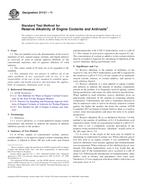We need your consent to use the individual data so that you can see information about your interests, among other things. Click "OK" to give your consent.
ASTM D1121-11
Standard Test Method for Reserve Alkalinity of Engine Coolants and Antirusts
STANDARD published on 1.10.2011
The information about the standard:
Designation standards: ASTM D1121-11
Note: WITHDRAWN
Publication date standards: 1.10.2011
SKU: NS-16376
The number of pages: 4
Approximate weight : 12 g (0.03 lbs)
Country: American technical standard
Category: Technical standards ASTM
The category - similar standards:
Annotation of standard text ASTM D1121-11 :
Keywords:
buffering, engine coolants, RA, reserve alkalinity: Acidity, alkalinity, pH--engine antifreezes/antitrusts/coolants, Antirusts, Buffering action, Engine coolants/concentrates, Reserve alkalinity (RA), ICS Number Code 71.100.45 (Refrigerants and antifreezes)
Additional information
| Significance and Use | ||||||
|
Reserve alkalinity is the number of millilitres, to the nearest 0.1 mL of 0.100 N hydrochloric acid (HCl) required for the titration to a pH of 5.5 of a 10-mL sample of an undiluted, unused coolant, antirust, or coolant additive, and unused or used solutions thereof. Reserve alkalinity is a term applied to engine coolants and antirusts to indicate the amount of alkaline components present in the product. It is frequently used for quality control during production, and values are often listed in specifications. When applied to used solutions, reserve alkalinity gives an approximate indication of the amount of remaining alkaline components. Unfortunately, the term is sometimes misused in that its numerical value is said to be directly related to coolant quality, the higher the number, the better the coolant. ASTM Committee D15 on Engine Coolants believes there is a need to correct some misconceptions and place the term in its proper perspective. Reserve alkalinity (R.A.) as defined in Section 3 of this method is the number of millilitres of 0.1-N hydrochloric acid required to titrate 10 mL of concentrated coolant to a pH of 5.5. The term is not a completely accurate description of the property being measured because “alkalinity” usually refers to the pH range above 7.0. A review of the origin of the term may be helpful in attempting to understand its proper use. When ethylene glycol was first used as an engine coolant, it was uninhibited. The need for inhibition soon became apparent and triethanolamine was incorporated. When solutions of this inhibited glycol were titrated with dilute hydrochloric acid, it was found that the steepest part of the neutralization curve occurred at a pH of about 5.0. Following the introduction of triethanolamine, other buffers, such as borates and phosphates, have been used. Titration to 5.5 was employed with these buffers which have an end point close to 5.5. Generally, most metals in an automotive cooling system corrode less in solutions which are mildly alkaline. The commonly used alkaline buffers, borates and phosphates, help to maintain this desirable alkalinity and a stable pH for substantial additions of acid. A well inhibited coolant contains smaller amounts of other inhibitors (in addition to the buffers), to give broad range corrosion protection for all of the metals found in the cooling system. These additional inhibitors may contribute very little to the titration, but they can provide excellent corrosion protection. The alkaline inhibitors provide buffering action and neutralize acids introduced into the coolant by exhaust gas leakage, by residual acid cleaner, or by the oxidation of ethylene glycol and propylene glycol. Some inhibitors which contribute little or no reserve alkalinity may give excellent corrosion protection to certain metals but have little capacity to combat acid contamination. In view of this, the magnitude of the R. A. in a coolant is not always a good criterion in determining its potential protective properties. In summary, the precaution against the misuse of reserve alkalinity is that the reserve alkalinity of an engine coolant solution is not a dependable measure of its ability to prevent corrosion, nor can it satisfactorily indicate the additional life of the solution. |
||||||
| 1. Scope | ||||||
|
1.1 This test method covers the determination of the reserve alkalinity of new, unused engine coolants, and liquid antirusts as received, of used or unused aqueous dilutions of the concentrated materials, and of aqueous dilutions of solid antirusts. 1.2 The values stated in SI units are to be regarded as the standard. 1.3 This standard does not purport to address all of the safety problems, if any, associated with its use. It is the responsibility of the user of this standard to establish appropriate safety and health practices and determine the applicability of regulatory limitations prior to use. |
||||||
| 2. Referenced Documents | ||||||
|
Similar standards:
Historical
1.5.2013
Historical
1.11.2009
Historical
1.10.2013
Historical
1.4.2010
Historical
1.7.2009
Historical
1.4.2010
We recommend:
Technical standards updating
Do you want to make sure you use only the valid technical standards?
We can offer you a solution which will provide you a monthly overview concerning the updating of standards which you use.
Would you like to know more? Look at this page.



 ASTM D3585-08(2013)..
ASTM D3585-08(2013).. ASTM D3634-99(2009)..
ASTM D3634-99(2009).. ASTM D4725-13
ASTM D4725-13 ASTM D4985-10
ASTM D4985-10 ASTM D5666-95(2009)..
ASTM D5666-95(2009).. ASTM D5752-10
ASTM D5752-10
 Cookies
Cookies
